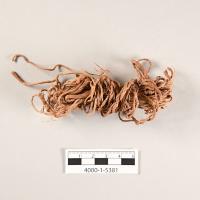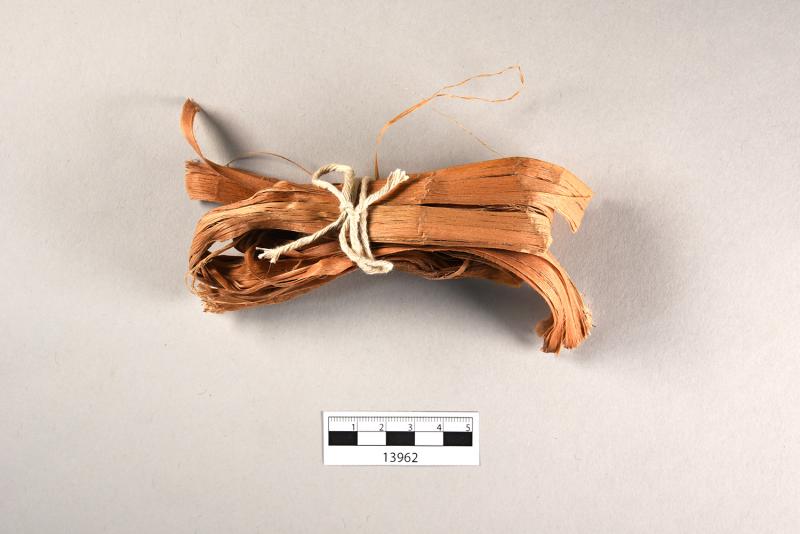Basswood Twine
Mrs. Hyman (Ada) Smith, with help from her husband Hyman, showed Volney Jones the techniques she used to make twine from the inner bark of a basswood tree (Tilia americana). In the 1930s, homemade twine was rapidly being replaced by string purchased from the store. Mrs. Smith learned how to make twine from her mother and demonstrated the steps to Jones.
Preparing the bark
Strips of bark that were four-inch wide and ten to fifteen feet long were stripped from the trunk of a basswood tree. The outer bark was discarded while the inner bark was rolled together. The stripped rolls of inner bark were then boiled in a solution of water and wood ashes until the layers separated. The bark was then rinsed with fresh water and hung to dry.
Making the twine
The strips of basswood bark are twisted together by hand. Mrs. Smith used one hand to hold two strips of basswood bark in place on her knee and twisted the bark clockwise two or three times, causing the strips of bark to twist into two tight cords. She repeated this process, rolling the bark in a reverse motion. She finished the twine using a counterclockwise motion to sharply twist the two cords together into a single two-strand piece of twine. The bark strips and the resulting two cords were twisted in opposite directions to prevented the strands from coming apart. The finished twine was rolled into 4-6” balls that was ready for use. If the twine dried and stiffened before use, it was soaked in water for two minutes to regain its flexibility.
Mrs. Smith used basswood twine for the weft and to create the border, also called the selvage, of the rush mat that she created for Volney Jones. Basswood twine was also used to tie up the rolled mat.
Wiigob - Inner Bark of the Basswood
Today, Anishinaabe (Odawa) natural fiber artist and teacher, Wasson (Renée) Dillard, continues the tradition of making basswood twine, which she calls cord. Wasson prefers the bark from the small stalks that are growing from a large basswood tree that has fallen over. The bark of these young stalks is smooth. She harvests part of the bark from individual stalks, so that they will continue growing. Bark from eight or nine stalks produces enough fiber for her weaving needs for the year.
Wasson uses two different retting techniques to prepare the basswood fibers. The first technique involves soaking the bark in the moving water of a small stream for most of the summer and produces fibers that are light tan. The other process is faster, taking only a day. She mixes ash from the wood burning stove in her studio with water and then boils the bark in it -- similar to the technique that Mrs. Hyman (Ada) Smith showed Volney Jones. This boiling technique produces fibers with a reddish patina. Like Mrs. Hyman (Ada) Smith, Wasson rolls the prepared basswood fibers on her thigh to twist them into twine.
In the spring of 2022, Wasson told the Museum Anthropological students that her parents, especially her mother, encouraged her to start weaving and learning to make traditional fibers when she was young. Wasson uses basswood twine to weave bags and bulrush mats that she makes for her community, the Little Traverse Bay Band of Odawa. She told the Museum Anthropology students that weaving is like a “time machine,” connecting the past, present, and future and connect her community to the earth.







